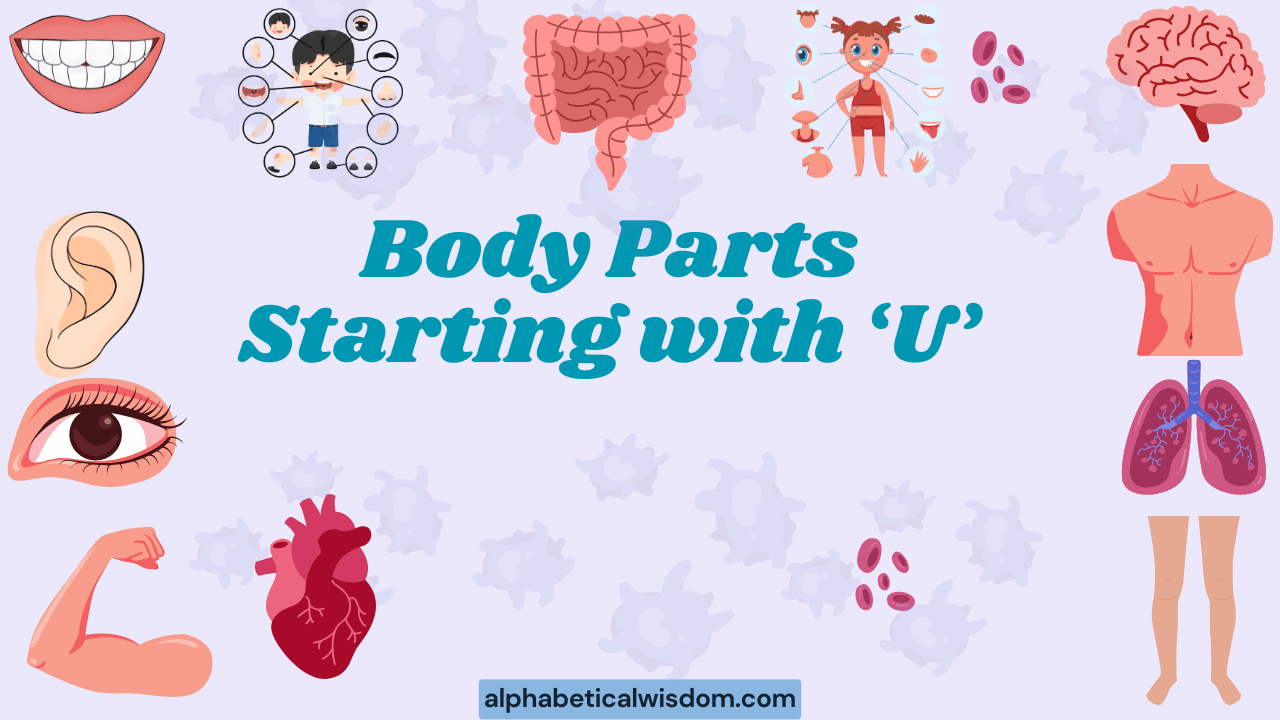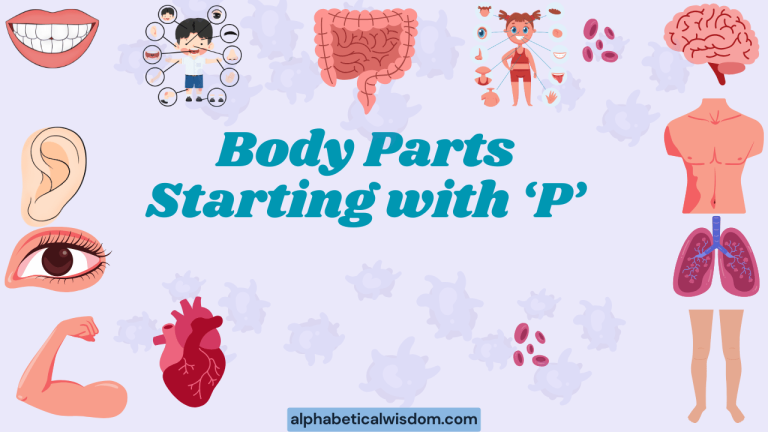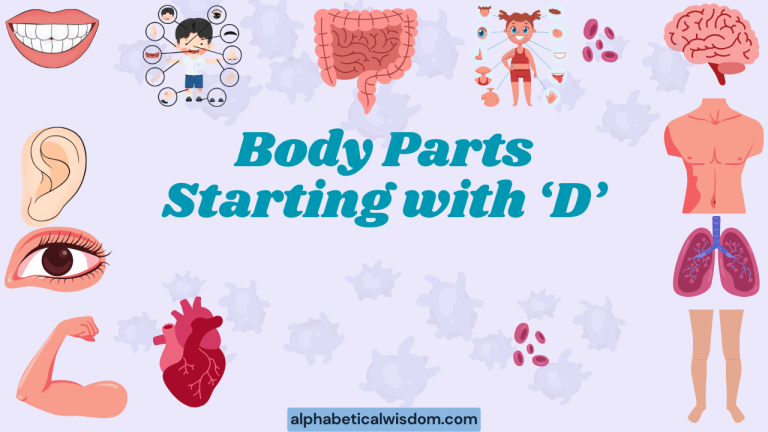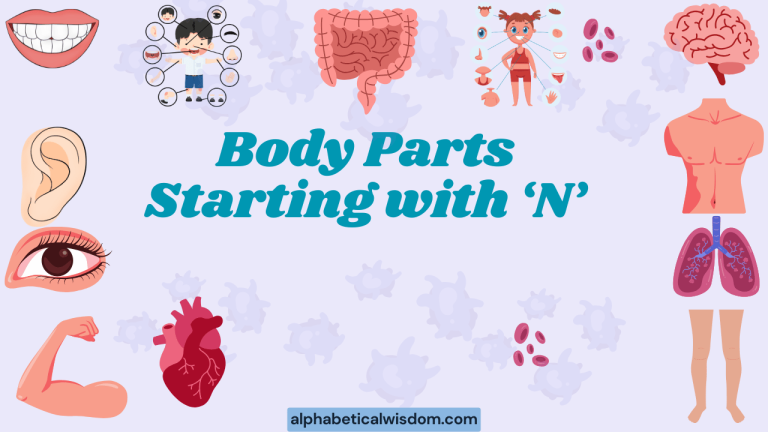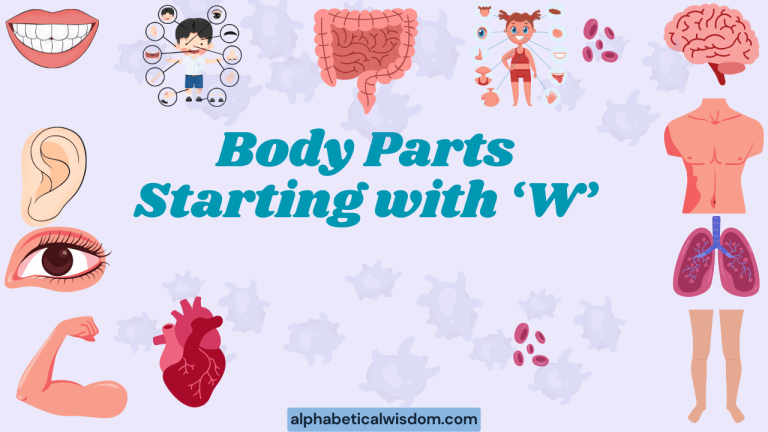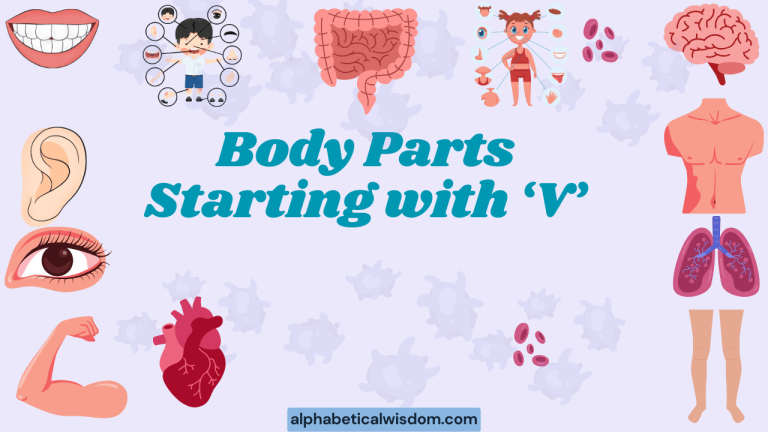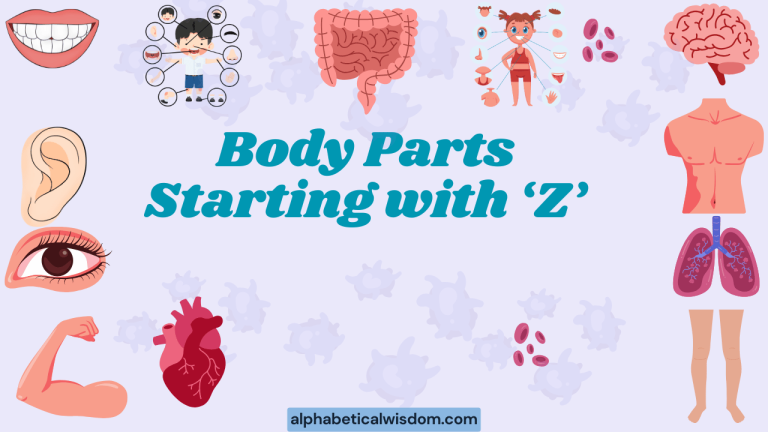Body Parts Starting with ‘U’: A Comprehensive Grammar Guide
Understanding the vocabulary related to body parts is essential for effective communication in English. Knowing the correct terms, especially those less common like body parts starting with “U,” enhances precision in medical, anatomical, and general conversations.
This guide is designed for English language learners, medical professionals, and anyone seeking to expand their anatomical vocabulary. Mastering these terms allows for clearer expression and comprehension when discussing health, anatomy, or physical descriptions.
Table of Contents
- Introduction
- Definition of Body Parts Starting with ‘U’
- Structural Breakdown
- Types and Categories
- Examples of Body Parts Starting with ‘U’ in Sentences
- Usage Rules
- Common Mistakes
- Practice Exercises
- Advanced Topics
- Frequently Asked Questions (FAQ)
- Conclusion
Definition of Body Parts Starting with ‘U’
Body parts starting with the letter “U” are relatively rare in anatomical terminology, but they do exist. These terms often refer to less commonly discussed or more specialized anatomical structures.
Understanding these terms requires careful attention to context, as some may have specific medical or anatomical meanings. This section aims to provide clear definitions and explanations of these body parts, ensuring a solid foundation for further learning.
Ulna
The ulna is a long bone found in the forearm, located on the side opposite the thumb (i.e., on the medial side). It extends from the elbow to the wrist and works in conjunction with the radius to facilitate forearm rotation and wrist movement. The ulna is crucial for the stability of the wrist and elbow joints, providing attachment points for several muscles involved in arm and hand function. Injuries to the ulna, such as fractures or dislocations, can significantly impair the use of the arm.
Umbilicus
The umbilicus, commonly known as the navel or belly button, is a scar on the abdomen caused by the detachment of the umbilical cord after birth. The umbilical cord provides nourishment and oxygen to the fetus during gestation. After birth, the cord is no longer needed and is clamped and cut, leaving behind the umbilicus. The appearance of the umbilicus varies from person to person, and it serves no physiological function after birth.
Structural Breakdown
Understanding the structural components of the ulna and umbilicus is key to appreciating their functions and potential vulnerabilities. The ulna, as a bone, has distinct parts that contribute to its role in supporting the forearm and enabling movement.
The umbilicus, while a scar, represents the point of connection to the body’s internal systems during fetal development. This section details the structural elements of each body part.
Ulna Structure
The ulna can be divided into several key structural components: the olecranon (the bony prominence at the elbow), the coronoid process (a triangular eminence projecting forward from the ulna), the ulnar tuberosity (an area below the coronoid process for muscle attachment), the shaft (the main body of the bone), the head (the distal end of the ulna), and the styloid process (a small projection at the distal end). Each of these parts plays a role in the ulna’s function and its interaction with other bones and muscles in the forearm.
Umbilicus Structure
The umbilicus is primarily composed of scar tissue. The area around the umbilicus may have varying degrees of skin pigmentation and texture. Internally, the umbilicus is connected to several ligaments and remnants of fetal blood vessels. These include the median umbilical ligament (a remnant of the urachus) and the medial umbilical ligaments (remnants of the umbilical arteries). These structures connect the umbilicus to the bladder and the internal iliac arteries, respectively, although they no longer serve their original fetal functions.
Types and Categories
While there aren’t distinct “types” of ulna or umbilicus in the same way as there are types of muscles or nerves, there are variations and conditions associated with each. For the ulna, these variations might include differences in size or shape, and conditions might involve fractures or deformities.
For the umbilicus, variations primarily concern its appearance, and conditions might involve hernias or infections. This section explores these categories and variations.
Ulna Variations and Conditions
Variations in the ulna can include differences in length or curvature, which may affect forearm mechanics. Conditions affecting the ulna include ulnar fractures (breaks in the bone), ulnar dislocations (displacement from the elbow joint), ulnar nerve entrapment (compression of the ulnar nerve), and ulnar collateral ligament injuries (damage to the ligament on the medial side of the elbow). These conditions can result from trauma, overuse, or underlying medical conditions.
Umbilicus Variations and Conditions
Variations in the umbilicus primarily relate to its appearance, such as whether it is an “innie” (concave) or an “outie” (convex). Conditions affecting the umbilicus include umbilical hernias (protrusion of abdominal contents through a weakness in the abdominal wall), umbilical infections (bacterial infections of the umbilicus, particularly in newborns), and granulomas (small, inflamed nodules that can form after the umbilical cord detaches). These conditions typically require medical attention to prevent complications.
Examples of Body Parts Starting with ‘U’ in Sentences
To fully understand how to use these terms correctly, it’s helpful to see them in context. The following tables provide numerous examples of sentences using “ulna” and “umbilicus” in different scenarios.
Each example is designed to illustrate the correct usage and meaning of the term.
Examples Using “Ulna”
The table below shows how to use the word “ulna” in different sentences.
| Sentence |
|---|
| The doctor examined the patient’s forearm to check for any fractures of the ulna. |
| He suffered an ulna fracture during the football game. |
| The surgeon repaired the damaged ligaments surrounding the ulna. |
| Pain in her wrist was traced back to a problem with the distal end of her ulna. |
| The X-ray showed a clear break in the ulna bone. |
| The physiotherapist focused on strengthening the muscles around the ulna. |
| The athlete’s range of motion was limited due to the injury to his ulna. |
| The medical student studied the anatomy of the ulna in detail. |
| The ulna and radius work together to allow rotation of the forearm. |
| The patient reported tenderness along the length of the ulna. |
| After the fall, she experienced severe pain in her ulna. |
| The fracture of the ulna required surgical intervention. |
| Proper rehabilitation is crucial after an ulna injury. |
| The ulna provides stability to the forearm. |
| He felt a sharp pain in his ulna when he tried to lift the weight. |
| The specialist confirmed that the pain in the elbow was related to the ulna. |
| She was diagnosed with ulna nerve entrapment. |
| The ulna is essential for wrist movement. |
| The anatomy textbook described the ulna as a long bone. |
| The patient’s ulna was immobilized in a cast. |
| The doctor explained that the ulna and radius are connected. |
| The ulna is a crucial part of the skeletal system. |
| During the surgery, the doctors focused on repairing the damaged ulna. |
| The ulna is one of the two bones in the forearm. |
Examples Using “Umbilicus”
The table below will show how to use the word “umbilicus” in different sentences.
| Sentence |
|---|
| The newborn’s umbilicus was carefully cleaned by the nurse. |
| The doctor checked the baby’s umbilicus for any signs of infection. |
| The appearance of the umbilicus varies from person to person. |
| An umbilical hernia is a condition where the umbilicus protrudes outwards. |
| The umbilicus is the scar left after the umbilical cord is cut. |
| She had her umbilicus pierced as a teenager. |
| The umbilicus marks the point where the umbilical cord was attached. |
| The surgeon repaired the umbilical hernia near the patient’s umbilicus. |
| The baby developed a small granuloma at the site of the umbilicus. |
| Proper hygiene is important to prevent infections of the umbilicus. |
| He had a prominent umbilicus, also known as an “outie.” |
| She preferred to keep her umbilicus covered. |
| The umbilicus is a reminder of the connection to the mother during pregnancy. |
| The baby’s umbilicus healed without complications. |
| The doctor explained the importance of keeping the umbilicus dry. |
| The umbilicus is sometimes referred to as the navel. |
| The patient complained of pain around the umbilicus. |
| The umbilicus serves no physiological function after birth. |
| The nurse advised on the best way to care for the baby’s umbilicus. |
| The umbilicus can be a site of infection if not properly cared for. |
| The umbilicus is a unique feature on each person’s body. |
| The doctor noted the appearance of the patient’s umbilicus during the examination. |
| The umbilicus is located in the center of the abdomen. |
Combined Examples: “Ulna” and “Umbilicus”
This table shows the use of both “ulna” and “umbilicus” in the same context.
| Sentence |
|---|
| While examining the baby’s umbilicus, the doctor noticed the mother also had a scar from an ulna fracture. |
| The medical textbook chapter covered both injuries to the ulna and common conditions affecting the umbilicus in newborns. |
| The patient mentioned a previous ulna injury while the nurse cleaned the area around his umbilicus in preparation for surgery. |
| “Remember to protect your ulna during sports,” the coach said, while pointing to a diagram showing the location of the umbilicus on a human body. |
| After the accident, both the ulna and the area around the umbilicus were sensitive to the touch. |
| The physical therapist focused on rehabilitating the injured ulna, while the pediatrician checked the healing of the baby’s umbilicus. |
| The anatomy lecture detailed the structure of the ulna and briefly mentioned the development of the umbilicus in utero. |
| He pointed to the location of his ulna, recounting how he broke it years ago, then jokingly compared it to his “innie” umbilicus. |
| The case study involved a patient with complications following an ulna fracture and an unrelated umbilical hernia near the umbilicus. |
| The doctor explained that while the ulna is essential for arm function, the umbilicus serves no purpose after birth except as a landmark. |
| She massaged lotion into her skin, carefully avoiding the sensitive area around her umbilicus and being mindful of her husband’s past ulna injury. |
| The children were fascinated by the different shapes of belly buttons (umbilicus) and learned about bone injuries, including fractures of the ulna in health class. |
Usage Rules
Using “ulna” and “umbilicus” correctly involves understanding their anatomical context and adhering to standard English grammar rules. These rules cover aspects such as pluralization, article usage, and appropriate context.
Correct usage ensures clarity and precision in both spoken and written communication.
Ulna Usage Rules
The word “ulna” is a singular noun. Its plural form is “ulnae.” When referring to a specific ulna, use the definite article “the.” When referring to ulnae in general, use the plural form without an article or with the indefinite article “some.” For example: “The ulna is a long bone.” “Some ulnae are more prone to fracture.”
Umbilicus Usage Rules
The word “umbilicus” is a singular noun. Its plural form is “umbilici” (though “umbilicuses” is also acceptable but less common).
When referring to a specific umbilicus, use the definite article “the.” When discussing umbilici in general, use the plural form without an article. For example: “The umbilicus is also called the navel.” “Umbilici vary in appearance.”
Common Mistakes
Several common mistakes can occur when using “ulna” and “umbilicus.” These mistakes often involve incorrect pluralization, misuse of articles, or confusion with similar-sounding words. Recognizing and correcting these errors is crucial for improving accuracy in English.
Incorrect: The ulnae is broken.
Correct: The ulna is broken.
Incorrect: I have two umbilicus.
Correct: I have one umbilicus.
Incorrect: She hurt her olna.
Correct: She hurt her ulna.
Incorrect: The doctor checked the babies umbilici.
Correct: The doctor checked the babies’ umbilici (or umbilicuses).
Practice Exercises
The following exercises are designed to test your understanding of the correct usage of “ulna” and “umbilicus.” Each exercise includes a variety of question types, such as fill-in-the-blanks, multiple-choice, and sentence correction. Answer keys are provided to help you check your work.
Exercise 1: Fill-in-the-Blanks
Fill in the blanks with the correct form of “ulna” or “umbilicus.”
| Question | Answer |
|---|---|
| 1. The patient fractured his ____ in the fall. | ulna |
| 2. The baby’s ____ was cleaned with antiseptic. | umbilicus |
| 3. The doctor examined both ____ in the patient’s forearms. | ulnae |
| 4. An umbilical hernia is a protrusion near the ____. | umbilicus |
| 5. The ____ is essential for forearm rotation. | ulna |
| 6. The appearance of the ____ varies from person to person. | umbilicus |
| 7. He felt a sharp pain in his ____ after the accident. | ulna |
| 8. The nurse checked the baby’s ____ for any signs of infection. | umbilicus |
| 9. The ____ and radius work together to facilitate wrist movement. | ulna |
| 10. The ____ is the scar left after the umbilical cord is cut. | umbilicus |
Exercise 2: Multiple Choice
Choose the correct sentence from the options provided.
| Question | Options | Answer |
|---|---|---|
| 1. Which sentence is correct? | (a) The ulna is broken. (b) The ulnae is broken. (c) The ulnas are broken. | (a) The ulna is broken. |
| 2. Which sentence is correct? | (a) The umbilicus are a scar. (b) The umbilicus is a scar. (c) The umbilici is a scar. | (b) The umbilicus is a scar. |
| 3. Which sentence is correct? | (a) He broke his ulnae. (b) He broke his ulna. (c) He broke his ulnas. | (b) He broke his ulna. |
| 4. Which sentence is correct? | (a) The baby’s umbilicus was clean. (b) The baby’s umbilici was clean. (c) The baby’s umbilicuses was clean. | (a) The baby’s umbilicus was clean. |
| 5. Which sentence is correct? | (a) Both ulna were fractured. (b) Both ulnae were fractured. (c) Both ulnas were fractured. | (b) Both ulnae were fractured. |
| 6. Which sentence is correct? | (a) Umbilicus vary in appearance. (b) Umbilici vary in appearance. (c) Umbilicuses vary in appearance. | (b) Umbilici vary in appearance. |
| 7. Which sentence is correct? | (a) The ulna and radius works together. (b) The ulna and radius work together. (c) The ulna and radius is working together. | (b) The ulna and radius work together. |
| 8. Which sentence is correct? | (a) The umbilicus is on the abdomen. (b) The umbilicus are on the abdomen. (c) The umbilici is on the abdomen. | (a) The umbilicus is on the abdomen. |
| 9. Which sentence is correct? | (a) An ulna fracture is painful. (b) A ulna fracture is painful. (c) The ulna fracture is painful. | (a) An ulna fracture is painful. |
| 10. Which sentence is correct? | (a) A umbilicus hernia is common in infants. (b) An umbilicus hernia is common in infants. (c) An umbilical hernia is common in infants. | (c) An umbilical hernia is common in infants. |
Exercise 3: Sentence Correction
Correct the following sentences, identifying any errors in the use of “ulna” or “umbilicus.”
| Incorrect Sentence | Correct Sentence |
|---|---|
| 1. The ulnae are a bone in the forearm. | The ulna is a bone in the forearm. |
| 2. The babies umbilicus was infected. | The baby’s umbilicus was infected. |
| 3. She broke both of her ulna. | She broke both of her ulnae. |
| 4. The umbilici is the scar left after birth. | The umbilicus is the scar left after birth. |
| 5. The doctor examined the ulnaes. | The doctor examined the ulnae. |
| 6. He has two umbilicus. | He has one umbilicus. |
| 7. The ulna and radius is connected. | The ulna and radius are connected. |
| 8. The umbilicus are located on the abdomen. | The umbilicus is located on the abdomen. |
| 9. The baby cryed because of the infection on their umbilicus. | The baby cried because of the infection on its umbilicus. |
| 10. Both ulna was fractured in the accident. | Both ulnae were fractured in the accident. |
Advanced Topics
For advanced learners, exploring the etymology and historical usage of “ulna” and “umbilicus” can provide a deeper understanding of these terms. Additionally, discussing the clinical significance of these body parts in medical contexts can enhance comprehension for those in healthcare fields.
This section delves into these advanced topics.
Etymology
The word “ulna” comes from the Latin word ulna, which means “elbow” or “forearm.” This reflects the bone’s location and function in the forearm. The word “umbilicus” also comes from Latin, derived from umbilicus, meaning “navel” or “center.” Its origin reflects its central position on the abdomen and its historical association with the center of life during fetal development.
Clinical Significance
In clinical settings, the ulna is significant in diagnosing and treating forearm injuries, such as fractures and nerve entrapments. The umbilicus is clinically important for identifying and managing umbilical hernias, infections, and other conditions, particularly in newborns.
Understanding the anatomy and potential pathologies of these body parts is crucial for healthcare professionals.
Frequently Asked Questions (FAQ)
This section addresses common questions learners have about the body parts “ulna” and “umbilicus.” These questions cover definitions, usage, and related concepts, providing clear and concise answers to enhance understanding.
- What is the main function of the ulna?
The ulna is a long bone in the forearm that works with the radius to facilitate forearm rotation and wrist movement. It also provides stability to the wrist and elbow joints. - What is the difference between an “innie” and an “outie” umbilicus?
An “innie” umbilicus is concave, meaning it curves inward. An “outie” umbilicus is convex, meaning it protrudes outward. The type of umbilicus is determined by how the skin heals after the umbilical cord is cut. - How can I prevent an umbilical hernia in my baby?
Umbilical hernias are often congenital and not preventable. However, proper care of the umbilical cord stump and avoiding excessive straining can help reduce the risk of complications. - What are the common symptoms of an ulna fracture?
Common symptoms of an ulna fracture include severe pain, swelling, tenderness, and limited range of motion in the forearm and wrist. - Is it normal for the umbilicus to bleed slightly after the umbilical cord falls off?
Yes, it is normal for the umbilicus to bleed slightly after the umbilical cord falls off. However, if the bleeding is excessive or accompanied by signs of infection, medical attention should be sought. - How long does it take for an ulna fracture to heal?
The healing time for an ulna fracture varies depending on the severity of the fracture and individual factors, but it typically takes 6-8 weeks for the bone to heal. - What is the best way to clean a newborn’s umbilicus?
The best way to clean a newborn’s umbilicus is to gently cleanse it with mild soap and water, then pat it dry. Avoid using alcohol or other harsh chemicals, as these can irritate the skin. - Can an ulna fracture lead to long-term complications?
If not properly treated, an ulna fracture can lead to long-term complications such as chronic pain, limited range of motion, and arthritis. Proper rehabilitation is crucial for optimal recovery. - What is the significance of the umbilicus in adults?
The umbilicus serves no physiological function in adults but remains as a scar marking the site of the umbilical cord attachment during fetal development. - How can I strengthen my ulna to prevent injuries?
Strengthening the muscles around the forearm and wrist through exercises and maintaining good bone health through a balanced diet and regular exercise can help prevent ulna injuries.
Conclusion
Mastering the usage of body part terms, including “ulna” and “umbilicus,” is essential for accurate and effective communication in English. This guide has provided comprehensive definitions, examples, and practice exercises to enhance your understanding.
Remember to pay attention to pluralization, article usage, and context to avoid common mistakes. Continued practice and attention to detail will solidify your knowledge and improve your fluency in English.
